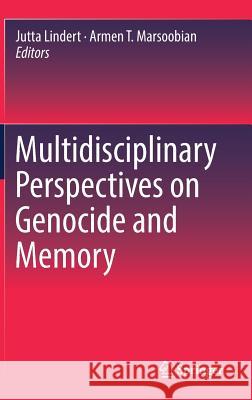Multidisciplinary Perspectives on Genocide and Memory » książka



Multidisciplinary Perspectives on Genocide and Memory
ISBN-13: 9783319655116 / Angielski / Twarda / 2018 / 326 str.
Multidisciplinary Perspectives on Genocide and Memory
ISBN-13: 9783319655116 / Angielski / Twarda / 2018 / 326 str.
(netto: 420,71 VAT: 5%)
Najniższa cena z 30 dni: 424,07
ok. 22 dni roboczych.
Darmowa dostawa!
This book explores the memory and representation of genocide as they affect individuals, communities and families, and artistic representations. Next, it reviews memories of genocide in bodies and in societies as well as genocide in memory through lives, mental health and transgenerational effects.
"An important volume on genocide studies ... . The book's strength is its disciplinary diversity. Readers across disciplines will benefit from discussions about memory practices from cultural and scientific perspectives. This diversity gives readers a unique chance to consider the range of issues with memory-making not often integrated into one book. ... Recommended. Graduate students, researchers, faculty, professionals." (C. Pinto, Choice, Vol. 56 (01), September, 2018)
1: Editors’ Introduction: Jutta Lindert, Armen T. Marsoobian.- Part I: The Concept of Genocide and the Role of Memory: 2: Definitions and Concepts of Genocide: Lemkin and the Concept of Genocide: Steve Leonard Jacobs.- 3: Conceptions of Genocide and the Ethics of Memorialization: Jeffrey Blustein.- 4: Jewish Social Memory and the Augmented Stages of Genocide: Shulamith Reinharz.- Part II: Genocide, Memory and Health: 5: Terror and Identity: The Case of Argentina and the Importance of the Different ‘Representations’ of the Past: Daniel Feierstein.- 6: Genocide and Its Long Term Mental Impact on Survivors – What We Know and What We Do Not Know: Jutta Lindert, Haim Y. Knobler, Moshe Abramowitz.- 7: Survival and Resilience versus Psychopathology: A Seven-decade Perspective Post-Holocaust: Haim Y. Knobler, Moshe Abramovitz, Jutta Lindert.- Part III: Genocide, Representation and Memorialization.- 8: The Face of War and Genocide: Jay Winter.- 9: When Past and Present Meet in Israeli Art: Memorialization of the Holocaust: Batya Brutin.- 10: How Do We Memorialize Genocide? The Case of the German Memorial to the Murdered Jews of Europe: Armen T. Marsoobian.- 11: The Suppression of Cultural Memory and Identity in Bosnia and Herzegovina: Prohibited Memorials and the Continuation of Genocide: David Pettigrew.- 12: British Media Representation of the War in Bosnia Herzegovina: Avoiding the Duties to Prevent and Protect: Charlotte McKee.- Part IV: Bearing Witness to Genocide in the Arts: 13: Some Notes on My Poems and Armenian Memory: Peter Balakian.- 14 : Poems: Peter Balakian.- 15: My Artistic Explorations of the Holocaust: Hans Guggenheim.- 16: Coming to Terms with the Past: The Vienna Project as an Interactive, Interdisciplinary Model of Memorialization: Karen Frostig.- 17: Collective Memory, Memorialization and Bearing Witness in the Aftermath of the Armenian Genocide: Armen T. Marsoobian.
Jutta Lindert, PhD, M.A is professor of Public Health at the Protestant University of Ludwigsburg, Ludwigsburg, Germany. She is visiting scientist at the University of Leipzig. Her research interests focus on the interplay of culture, biology, life events and mental health, and on the long term health impact of violence on health and mental health. Additionally, she is investigating factors which influence ageing among others historical events, genetic and environmental factors. Jutta is president of the Section of Public Mental Health of the “European Association of Public Health” and is currently preparing a study on the long term effects of child maltreatment in several countries in Europe and Latin America. Jutta has published many articles in scientific and nonscientific journals and is currently editing two books which will be published by Springer. As former head of refugee camp she is dedicated to investigating differences in health and methods and possibilities to overcome those. Before her career in Public Health Jutta has studied literature focusing on possibilities to write poems and literature on war and genocide. She is now Professor of Public Health at the University of Emden.
Armen T. Marsoobian is a professor of philosophy at Southern Connecticut State University and chairperson of the Philosophy Department. He holds a Ph.D. in philosophy from the State University of New York at Stony Brook. His primary areas of research are American philosophy, aesthetics, Peircean semiotics, metaphysics and genocide studies. His articles on Dewey, Peirce, Buchler, Emerson, pragmatism, aesthetics, and genocide studies have appeared in a variety of journals and anthologies. He has co-edited two books in systematic metaphysics, the first an expanded and revised edition of Justus Buchler's Metaphysics of Natural Complexes, the second, an anthology of essays on philosophical naturalism entitled Nature's Perspectives: Prospects for Ordinal Metaphysics. He published an anthology of essays on classic American philosophy, entitled The Blackwell Guide to American Philosophy. This book has recently appeared in a Russian language edition. He has also co-edited an anthology of philosophical essays on issues of justice and reconciliation after genocide entitled, Genocide's Aftermath: Reconciliation and Repair. He is editor-in-chief of the Wiley-Blackwell philosophy journal Metaphilosophy and is also general series editor for monographs in contemporary philosophy entitled, Metaphilosophy Series in Philosophy, published by Wiley-Blackwell Publishers.
This book explores the memory and representation of genocide as they affect individuals, communities and families, and artistic representations. It brings together a variety of disciplines from public health to philosophy, anthropology to architecture, offering readers interdisciplinary and international insights into one of the most important challenges in the 21st century. The book begins by describing the definitions and concepts of genocide from historical and philosophical perspectives. Next, it reviews memories of genocide in bodies and in societies as well as genocide in memory through lives, mental health and transgenerational effects. The book also examines the ways genocide has affected artistic works. From poetry to film, photography to theatre, it explores a range of artistic approaches to help demonstrate the heterogeneity of representations. This book provides a comprehensive and wide-ranging assessment of the many ways genocide has been remembered and represented. It presents an ideal foundation for understanding genocide and possibly preventing it from occurring again.
1997-2026 DolnySlask.com Agencja Internetowa
KrainaKsiazek.PL - Księgarnia Internetowa









